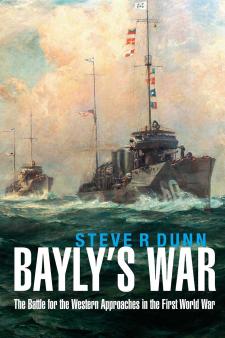
Bayly’s War: The Battle for the Western Approaches in the First World War. By Steve R. Dunn. Seaforth Publishing, Barnsley, 2018.
Reviewed by John Johnston
THIS book addresses one of the less explored aspects of the First World War, the British response to the U-boat offensives around the coasts of Ireland and in the waters off the southwest of Great Britain. Drawing on printed and documentary sources from Britain, Ireland, the USA, Australia, and New Zealand, Steve Dunn describes how the Royal Navy used aggressive patrolling by sloops and auxiliaries, armed merchantmen and fishing vessels, to deter attacks on shipping and developed decoys, known as Q-ships, to lure U-boats to their destruction.
Nevertheless, British tactics did little to stop U-boat attacks and it was not until May 1917, when a US Navy destroyer squadron deployed to Queenstown, that convoys could be escorted across the Atlantic and so the tonnages lost to U-boat actions curtailed.
In telling this story and in considering how, in spite of disappointments, the British maintained their morale and fighting spirit, the centrepiece of the narrative is the biography of Vice Admiral Sir Lewis Bayly, who was in charge of the Western Approaches Command from August 1915 until April 1919. Dunn shows how Bayly revitalised a command demoralised by constant failures against the Germans through what we would now describe as mission command and how he set an example of discipline, professionalism, and action that encouraged the young officers and crews of the sloops and auxiliary vessels which made up his command. Bayly’s interpersonal skills also came to the fore in establishing good working relations with the Catholic bishop at the start of his tenure and later in integrating the RN and USN into a single organisation. The latter was particularly pertinent because relations between the two navies had been poor, but Bayly ensured that the British and Americans worked together as equal partners, setting an example himself when he nominated the senior USN officer to take command whilst he went on leave.
Inevitably in a study involving Ireland, attention will turn to the events of Easter 1916, when ‘Britannia’s sons with their long-range guns sailed out of the foggy dew’ to bombard rebel garrisons along the Liffey. The Navy, however, was doing more than shelling Dublin. Naval intelligence in London had picked up signals from the ‘Aud’, a German freighter carrying arms and ammunition for the forthcoming rising: the ship was intercepted on Good Friday. When the rising started, Bayly made a show of force to subdue Cork and deployed sloops and auxiliary vessels to secure vital installations around Dublin and relieve the outnumbered British forces whom the rebels had cut off in Galway by blocking the routes across country. If nothing else, the events of Easter Week show how control of the seas is a force multiplier in land operations.
Dunn’s work is a fine piece of historical writing. The growing U-boat menace before the sinking of the ‘Lusitania’ provides the backdrop for examining weaknesses the long peace of the nineteenth century had engendered in the navy and demonstrating how the existence of the High Seas Fleet precluded transferring vessels from the Grand Fleet or the Battle Cruiser Squadron to reinforce the Western Approaches. Secondly, relations and encounters between naval personnel – USN as well as RN – and the civil population reveal the tensions that would explode in the Irish revolution and the impatience and incomprehension of the British military towards Irish nationalism. Finally, as many of those who served in the Queenstown destroyer squadron would later occupy senior positions in the USN, in US public life, and in the Roosevelt and Truman administrations, Dunn is also laying a trail for exploring the development of the special relationship between the US and the UK.



